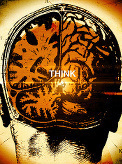Awaiting a theory of neural weather
 In a recent New York Times editorial, psychologist Gary Marcus noted that neuroscience is still awaiting a ‘bridging’ theory that elegantly connects neuroscience with psychology.
In a recent New York Times editorial, psychologist Gary Marcus noted that neuroscience is still awaiting a ‘bridging’ theory that elegantly connects neuroscience with psychology.
This reflects a common belief in cognitive science that there is a ‘missing law’ to be discovered that will tell us how mind and brain are linked – but it is quite possible there just isn’t one to be discovered.
Marcus writes:
What we are really looking for is a bridge, some way of connecting two separate scientific languages — those of neuroscience and psychology.
Such bridges don’t come easily or often, maybe once in a generation, but when they do arrive, they can change everything. An example is the discovery of DNA, which allowed us to understand how genetic information could be represented and replicated in a physical structure. In one stroke, this bridge transformed biology from a mystery — in which the physical basis of life was almost entirely unknown — into a tractable if challenging set of problems, such as sequencing genes, working out the proteins that they encode and discerning the circumstances that govern their distribution in the body.
Neuroscience awaits a similar breakthrough. We know that there must be some lawful relation between assemblies of neurons and the elements of thought, but we are currently at a loss to describe those laws.
The idea of a DNA-like missing component that will allow us to connect theories of psychology and neuroscience is an attractive one, but it is equally as likely that the connection between mind and brain is more like the relationship between molecular interactions and the weather.
In this case, there is no ‘special theory’ that connects weather to molecules because different atmospheric phenomena are understood in multiple ways and across multiple models, each of which has a differing relationship to the scale at which the physical data is understood – fluid flows, as statistical models, atomic interactions and so on.
In explanatory terms, ‘psychology’ is probably a lot like the weather. The idea of their being a ‘psychological level’ is a human concept and its conceptual components won’t neatly relate to neural function in a uniform way.
Some functions will have much more direct relationships – like basic sensory information and its representation in the brain’s ‘sensotopic maps’. A good example might be how visual information in space is represented in an equivalent retinotopic map in the brain.
Other functions will have more more indirect relationships but in great part because of how we define ‘functions’. Some have very empirical definitions – take iconic memory – whereas others will be cultural or folk concepts – think vicarious embarrassment or nostalgia.
So it’s unlikely we’re going to find an all-purpose theoretical bridge to connect psychology and neuroscience. Instead, we’ll probably end up with what Kenneth Kendler calls ‘patchy reductionism’ – making pragmatic links between mind and brain where possible using a variety of theories and descriptions.
A search for a general ‘bridging theory’ may be a fruitless one.
Link to NYT piece ‘The Trouble With Brain Science’.


Tom Stafford's Blog
- Tom Stafford's profile
- 13 followers



